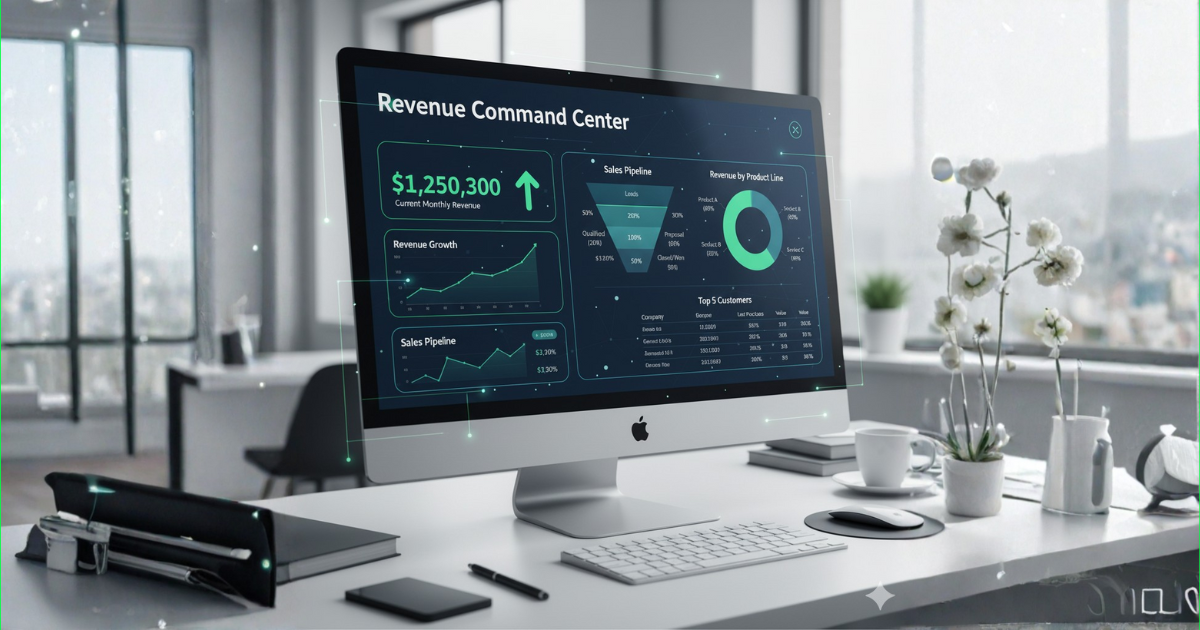Read Time: 8 min
You check your CRM every morning. Deals sit in stages for weeks. Pipeline reports show numbers you don't trust. Your sales team complains the system creates more work than it solves.
You're not alone. Most service business owners confuse their CRM with a revenue system. They're not the same thing. One stores data. The other generates cash. This gap costs businesses millions in lost opportunity and wasted founder time.
Key Takeaways
-
Revenue systems generate cash; CRMs store data. One is an engine, the other is a filing cabinet
-
The gap between tools and systems costs 36+ hours weekly in manual work and random results
-
Professional systems eliminate founder dependency through strategy playbooks, execution software, and AI workers
What a Revenue System Actually Is
A revenue system is the complete framework that makes revenue predictable, not random. It combines strategy playbooks that tell you what to do, execution software that runs it automatically, and AI workers that handle repetitive tasks 24/7.
Think of it like a factory. Your CRM is the filing cabinet in the corner. The revenue system is the entire assembly line. Machines, workers, quality control, and shipping.
The system spans four layers. First, it finds ideal prospects. Second, it nurtures them through proven sequences. Third, it books meetings automatically. Fourth, it keeps customers coming back. Each layer feeds the next. Leads move forward without you touching them.
Traditional CRM platforms store customer information. They're good at tracking names, emails, and past conversations. But they don't actively generate pipeline. They don't qualify prospects. They don't book meetings. They document what happened. They don't make things happen.
Consider the typical service business under $2M in revenue. The owner uses 5 to 12 disconnected tools. A CRM for contacts. An email platform for campaigns. Calendar software for scheduling. Proposal tools for quoting. Billing systems for invoicing. Analytics dashboards for reporting.
Each tool requires manual updates. Data lives in silos. Nothing talks to anything else. The owner becomes the integration layer, spending hours weekly moving information between systems.
A revenue system unifies this chaos into one command center. Everything runs from one dashboard. Email, SMS, social outreach, calendar automation, pipeline tracking. All connected.
Revenue systems enable founder-optional growth. The business runs during vacation. Pipeline fills automatically. Meetings book while you sleep. This isn't passive income mythology. It's methodology plus technology plus execution.
The Three Components That Make Systems Work
Revenue systems have three integrated pillars. Each serves a distinct function. Together, they multiply your results.
Strategy playbooks provide step-by-step sequences proven across hundreds of businesses. They document exactly what to do, when, and how. No guesswork. A cold outreach playbook maps find, personalize, engage. A nurture sequence playbook structures educate, build trust, convert. A meeting booking playbook defines qualify, schedule, confirm.
These aren't generic templates. They're working blueprints built for your industry, your buyers, and your sales cycle. They solve the amateur problem: random acts of marketing that produce random results. Professionals document what converts, replicate it across accounts, and measure outcomes.
Execution software consolidates your 5 to 12 tool stack into one unified platform. The command center provides complete visibility. Every prospect, every stage, every touchpoint. Core modules include contact management, pipeline views, campaign automation across email, SMS, and social channels, calendar coordination, and real-time analytics.
Software eliminates you as the integration layer. When prospect data enriches automatically, email sequences trigger based on behavior, meetings book via calendar sync, and activity logs without manual entry, friction disappears. Sales teams spend 4 to 5 hours weekly on manual forecasting and data entry. Automation recovers that time for actual selling.
AI workers function as specialized agents executing specific tasks without human help. The Finder identifies ideal prospects matching your profile. The Enricher gathers contact information. The Writer personalizes every message based on prospect signals. The Sender manages outreach timing. The Booker coordinates calendars and confirms appointments.
These aren't chatbots. They're specialized agents trained on conversion patterns and response data. One agent doesn't replace your team. The agent fleet handles repetitive work. Prospecting, enrichment, follow-up, scheduling. So humans focus on relationship-building and closing.
The three pillars compound. Strategy tells software what to execute. Software coordinates AI workers. Workers generate data that refines strategy. This feedback loop creates systematic improvement: 11.3% response rates versus industry average 1.8%, pipeline velocity doubled, and customer acquisition cost cut by 75%.
Amateur Approaches That Break Revenue
Most service businesses operate in survival mode, not system mode. They hustle. They grind. They work 70-hour weeks chasing random leads through disconnected tools. Revenue remains unpredictable. This isn't laziness. It's lack of architecture.
Amateur pattern one: Founder dependency. Every decision flows through the owner. Every client relationship belongs to the owner. Every proposal requires owner approval. The business isn't a business. It's an expensive job. When the founder stops working, revenue stops. No vacation. No sick days. No scale.
One consultant discovered he'd become the bottleneck in 47 daily decisions, working 65 hours weekly while team capacity sat idle. Research shows 60% of service businesses remain heavily founder-dependent, destroying millions in potential value because buyers won't acquire businesses where growth depends on one person.
Amateur pattern two: Tool chaos. Marketing runs campaigns in one platform. Sales logs calls in CRM. Proposals live in Google Docs. Billing happens in QuickBooks. Calendar sync breaks weekly. Nothing integrates cleanly. The average sales team manages data across 10+ disconnected systems, wasting 30% of productive time on manual data entry.
Data quality suffers. 47% of organizations cite poor data quality as their top CRM challenge. 44% still rely on manual processes to combine information. When email activity doesn't log automatically and meeting notes require manual entry, teams abandon the CRM entirely. They revert to spreadsheets, email folders, and memory.
Amateur pattern three: No repeatable process. Each rep runs their own system. One sends three follow-ups. Another sends seven. One calls immediately. Another waits three days. Sales becomes a personality contest, not a predictable engine. Without documented stages and clear progression rules, pipeline reports mean nothing.
Amateur pattern four: Manual follow-up dependency. Leads go cold after 1 to 2 touches because reps forget or don't have time. Industry data shows 60% of customers say "no" four times before saying "yes," but 48% of salespeople never follow up even once after initial contact. The math is brutal: companies spend thousands generating leads, then lose 70 to 80% to follow-up failure.
Amateurs hustle. Pros systemize. The difference: one is a job, the other is a business.
The 5-Point System Diagnostic
Professional revenue systems follow a clear diagnostic that exposes gaps and prioritizes fixes. Use these five questions to assess your current state.
1. Revenue model clarity: Can you forecast next quarter's revenue within 10% accuracy? If your answer involves "it depends" or "we'll see how things go," you lack a revenue model. You have revenue hope. Professionals build mathematical models showing how growth compounds. Unit economics, customer lifetime value (what one customer is worth over time), acquisition cost, payback periods.
2. ICP definition (Ideal Customer Profile): Who is your ideal customer? Beyond basic demographics, what signals indicate buying intent? Amateurs say "small businesses" or "companies with 10 to 100 employees." Professionals define: B2B service businesses under $2M annual revenue, founder-led sales, using 5 to 12 disconnected tools, pain threshold reached after 18 months of manual chaos, conversion probability 35% when all signals present.
3. Pipeline architecture: What are your funnel stages, conversion rates, and speed metrics at each transition? Can you identify where deals stall? Professionals map clear stage definitions with evidence-based exit criteria, not gut feel progression. "Discovery" requires documented pain point, budget range, decision timeline, and authority confirmation. No documentation, no advancement.
4. Response velocity tracking: What's your response time for inbound leads? For outbound follow-up? Industry data shows response within 5 minutes converts 9x better than response after 30 minutes. Yet most businesses take 42 hours to respond to web leads. Professionals set operational standards: inbound response under 5 minutes, outbound follow-up within 24 hours, meeting confirmation within 2 hours.
5. Technology integration: Do your systems talk to each other without manual data transfer? When email activity auto-logs to CRM, meeting notes sync automatically, contact updates spread across platforms, and pipeline changes trigger actions, friction disappears. Integration eliminates the 60 to 80 hours per rep spent on manual updates during typical platform setups.
This 5-point framework creates the foundation for systematic growth. Each gap identified becomes a prioritized fix. Each fix implemented compounds with others.
Proof: What Systems Actually Deliver
Real revenue systems produce measurable outcomes, not vague promises.
Robert, a 63-year-old accountant, worked 70-hour weeks generating $443K annually. After implementing a revenue system, he cut his hours to 34 per week while revenue increased to $900K. Time recovered: 36 hours per week. Revenue lift: 103%.
Another B2B service firm consolidated 12 disconnected tools into a unified revenue system. First 30 days: 50 qualified leads generated, 20 meetings booked automatically, 5 deals in pipeline. Previous 30 days with old approach: 18 leads, 7 meetings, 1 deal. Lead volume increase: 178%.
Response rates prove system superiority. Industry average email response rate: 1.8%. Revenue system with AI personalization and behavioral triggers: 11.3%. That's 6.3x improvement, not through better copywriting, but systematic optimization of send timing, personalization depth, and follow-up cadence.
| Factor | Amateur Hustle | Professional System |
|---|---|---|
| Weekly Hours | 70 hours | 34 hours |
| Revenue Predictability | Random, feast-famine | Predictable within 10% |
| Founder Dependency | Business stops without owner | Runs during vacation |
| Tool Count | 5 to 12 disconnected | 1 unified platform |
| Follow-up Success | 20 to 30% completed | 95%+ automated |
Your Next Step: System or Status Quo
You face a choice. Keep doing what you're doing, hustling 70 hours for random results, or build the system that generates predictable revenue whether you're working or not.
The CRM you're using right now isn't the problem. It's incomplete. CRMs store data. Revenue systems generate cash. Your CRM is a component of a revenue system, not the system itself.
Start with one systematic change. Pick the amateur pattern costing you most: founder dependency on sales calls, tool chaos consuming 10+ hours weekly, no documented sales process, manual follow-up failure, or random results masking pipeline reality. Fix one. Measure outcome. Compound from there.
If you're working 70 hours weekly while revenue remains unpredictable, you don't have a motivation problem. You have an architecture problem. The business structure creates the outcome. Change the structure, change the outcome. Systems scale. Heroes don't.
See how Markster systematizes this →
FAQs
Q: Can't I just upgrade my CRM to get these results?
A: No. CRMs are designed as data repositories, not execution engines. Adding more features to your CRM is like adding more filing cabinets to a factory. It doesn't change what gets built. You need the complete system: strategy playbooks, execution software, and AI workers working together.
Q: How long does it take to build a revenue system?
A: Foundation customers see 50+ qualified leads and 20+ booked meetings in the first 30 days. Full system maturity, where the business runs during your vacation, typically takes 90 days. The timeline depends on your starting point and how quickly you can document current processes.
Q: What if my business is too small for this level of systematization?
A: If you're working 50+ hours weekly and revenue depends on you personally, you're ready. Revenue systems eliminate founder dependency at any revenue level. We've seen $200K businesses and $5M businesses benefit equally. The principles scale to any service business size.




